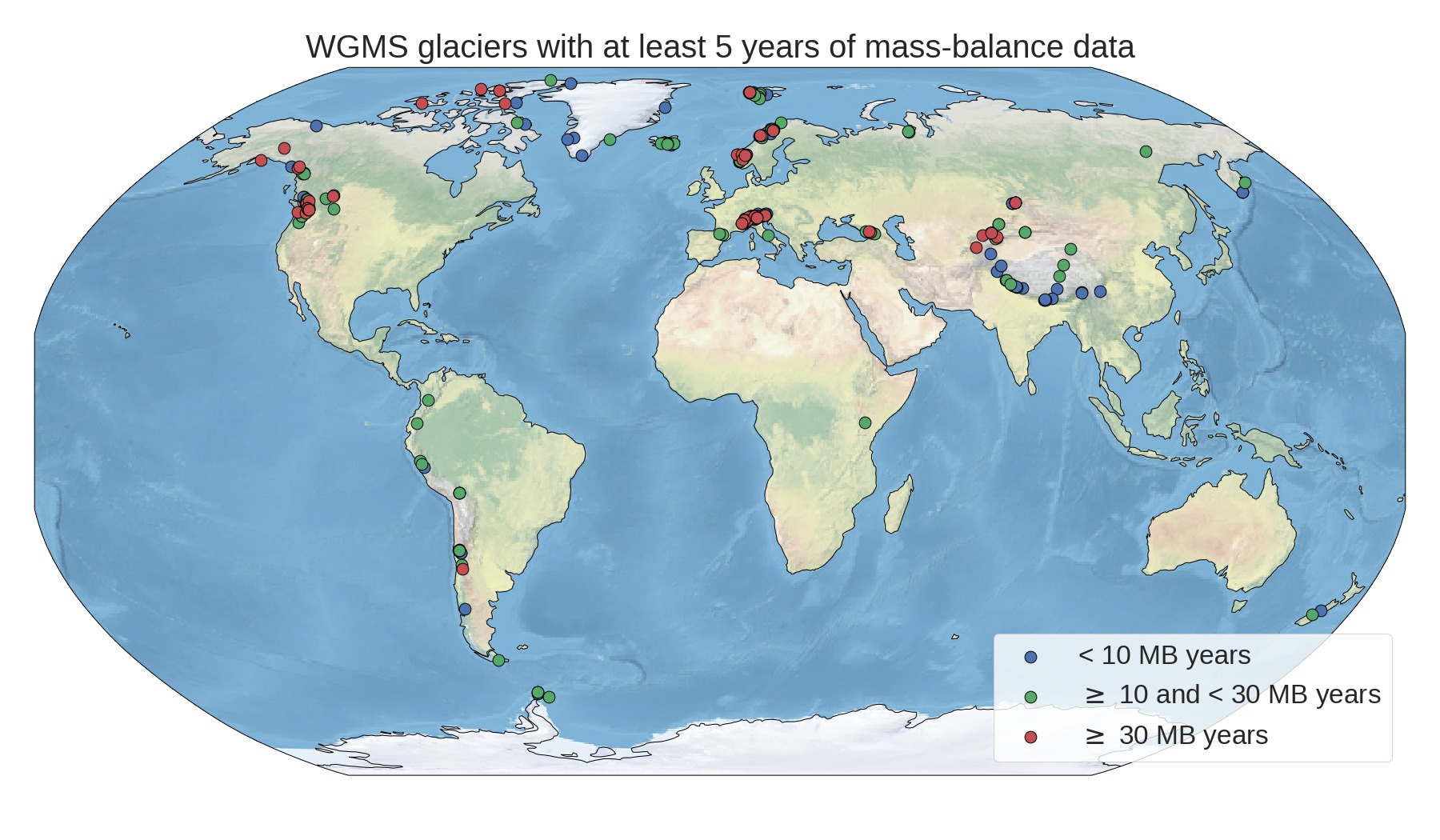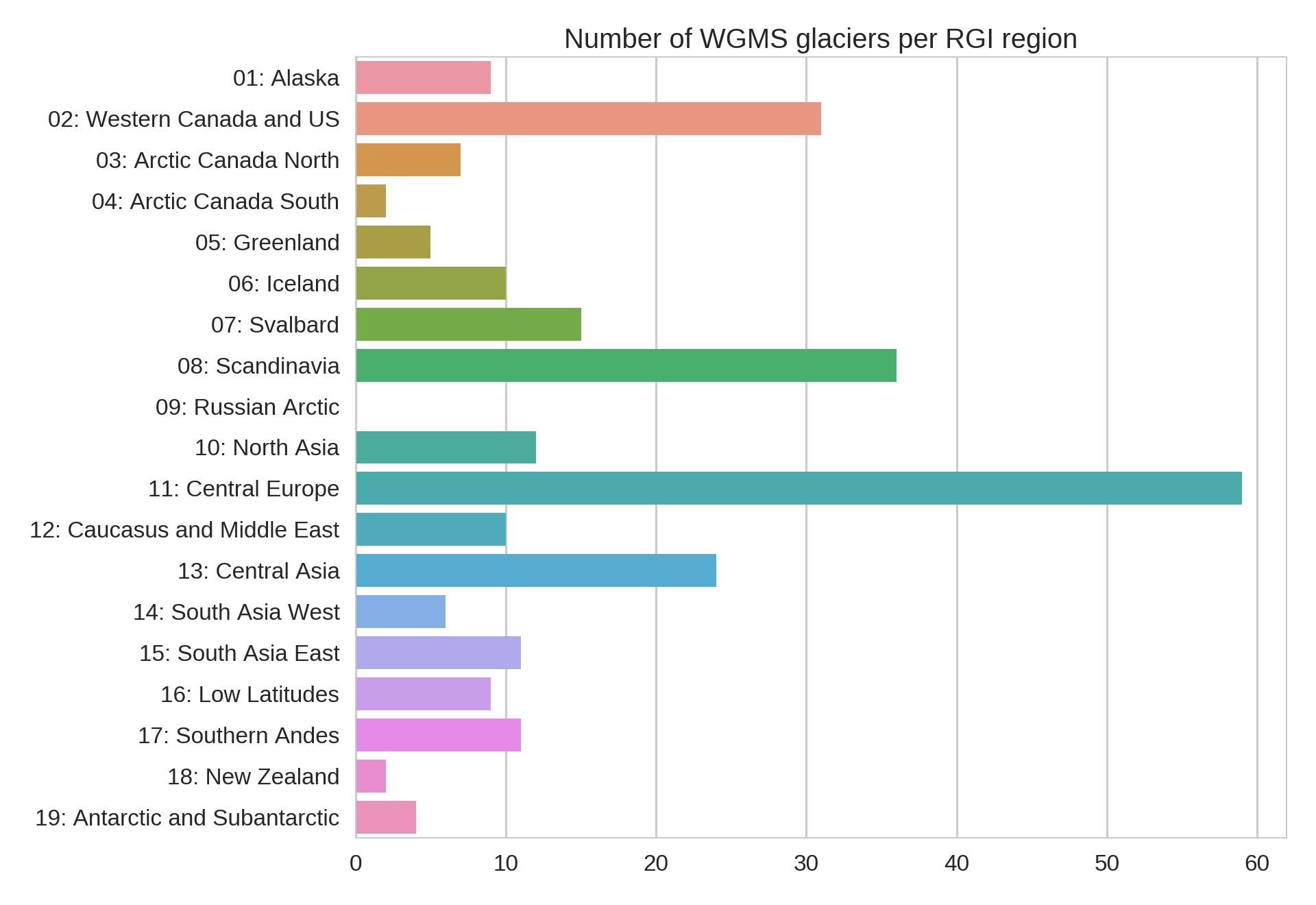The latest release of the World Glacier Monitoring Service (WGMS) Fluctuations Of Glaciers (FoG) database (WGMS, 2016) ships with a new lookup table, linking the glaciers in the WGMS database to those in the Randolph Glacier Inventory (RGI, Version 5).
The problem
Let’s provide a little bit of context before going on. The RGI is the first and, as of today, the only global inventory of glacier outlines available1. WGMS-FoG is the reference database for surface mass-balance observations2. Each year, various institutes around the globe send their data to the WGMS, which centralizes and publishes them.
So far, so good. Glacier modelers can use the RGI to initialise their model simulations, and perhaps use the WGMS mass-balance data to calibrate and validate their mass-balance model. At least this is how our homegrown model does it.
The problem is that both databases are unaware of each other. The reasons for this discrepancy are sometimes obvious, sometimes not:
- most WGMS identifiers pre-date the RGI (which was first published in 2012). Indeed, the RGI identifiers have to be attributed automatically to each of the 212,136 inventorized glaciers worldwide
- in several cases, the WGMS entries were outdated (inaccurate lon/lat coordinates due to glacier shrinkage, missing decimals, or simple reporting problems)
- the researchers working on the field might have a different definition of “their” glacier than the one provided by the RGI (i.e. geometry, location of the ice divides, etc.)
- sometimes, the apparently simple definition of “glacier entity” is problematic. While the RGI intends to provide a snapshot of glacier outlines at a certain date, the WGMS can store glacier data over several decades. During that time, a large glacier complex might break up in several tributaries which have no dynamical connection any more
With these issues in mind, the “RGI working group on linkage between databases”3 started to work on this problem a couple of years ago, and the list was finalized by the WGMS in 2016. I summarize here the results of this collaborative effort.
The links
Note: the code used to make these analyses is available here
The lookup table contains 4,331 links between the various databases (WGMS, WGI, GLIMS, and RGI), and 2,959 with the RGI alone. Most of them have been created automatically by intersecting the WGMS lon/lat coordinates with the RGI V5 polygons. Several mass-balance glaciers have then been checked manually and led to a correction in the original WGMS entry.
The WGMS database has 427 glaciers with mass-balance data, out of which 283 glaciers have more than 5 years of mass-balance4. However, not all of them are directly usable. There are some duplicates, such as the Careser glaciers (which broke up around 2009 and now have distinct WGMS identifiers - but only one RGI polygon). Finally, this leaves us with 263 glaciers linked between the WGMS and the RGI5.
These 263 glaciers have very different mass-balance record lengths:

The majority of glaciers (201) have less than 30 years of data. The longest timeseries are found in Europe, North-America, and the ex-USSR:

According to the RGI classification, most of these data are obtained on land-terminating (“valley”) glaciers. 28 records are from ice-caps, and 8 of the records are from marine-terminating glaciers.
Observational bias
These numbers have to be compared to the 212,136 glaciers worldwide. While the map above seems to show that there are observations almost everywhere where glaciers are found on the globe, there is in fact a significant regional bias:

With almost 60 glaciers, the European Alps are overrepresented in comparison to Asia or Antarctica. This bias becomes much stronger if you take into account the different glaciated areas between the RGI regions:

The last graph shows that many regions (especially at high latitudes) have comparatively far less observations than European locations.
Data availability
The data is available from the WGMS and the RGI websites. The filtered lookup table used by OGGM and the corresponding mass-balance time series can be found on our dedicated repository (if you use the later link, please refer to the WGMS and RGI as official providers of the data).
Notes
-
The GLIMS database is centralized and just reached global completeness. it will provide a good alternative to the RGI in the near future. ↩
-
I also mention the GMBAL database provided by Graham Cogley, which is - as far as I know - largely merged in the WGMS. ↩
-
Valentina Radić and Rachel Lo (University of British Columbia) provided a first list, which was then complemented by Graham Cogley (Trent University), who published it on the RGI website. In 2016, Ben Marzeion (Universty of Bremen) hired Johannes Landmann (University of Innsbruck) to formalise and automatize the process under my supervision. The results of his work can be found on this github repository. Johannes then moved to Zürich and finalized this work: the WGMS published the first list in August 2016. The original list needed several corrections, but the final list was sent to us again in early 2017. ↩
-
Five years of data is an arbitrary threshold we chose to use to determine which glaciers should be considered for validation ↩
-
removing the duplicates leaves us with 16 glaciers which have yet to be linked. The problem here is that there are strong discrepancies between the RGI and the WGMS, and that the RGI outlines are partly missing ↩